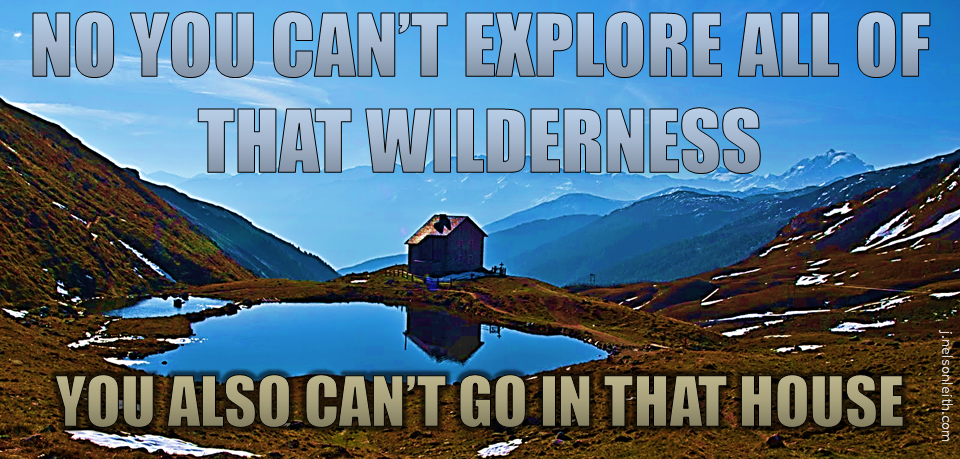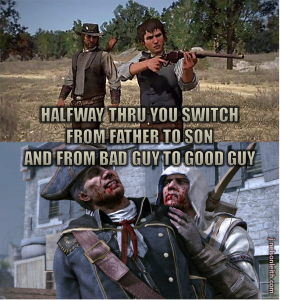 We’re getting ready to get the computing smack-down laid on our gamer brains by a new generation of consoles, including the Wii U, the Playstation 4, and the Xbox One.
We’re getting ready to get the computing smack-down laid on our gamer brains by a new generation of consoles, including the Wii U, the Playstation 4, and the Xbox One.
I know each of these platforms already has a boatload of games in the works, but nevertheless I’d like to offer my two cents to 8th Generation game designers, specifically on how to make better open-world games.
_
1. ASSIGN SPACE BETTER = BIGGER WILDERNESS AREAS + FLESHED-OUT SETTLEMENTS

A lot is being said about scale in next-gen games. For example, a major hype point for Grand Theft Auto V is that its enormous game world can fit San Andreas, Grand Theft Auto IV, and Red Dead Redemption inside of it.
Well, all I have to say about that is big frickin’ deal if that enormous game world is filled with buildings you can’t go inside and people who do nothing but mumble and act on a simplistic Flight-Fight algorithm.
Certain types of game terrain benefit from a sense of scale. Specifically, wilderness types of terrain. When traveling through woods and seas and deserts and plains, the repetition and vastness add to the ambiance.
But, game designers seem to like cramming their wilderness areas with frustratingly dense settlement patterns, so that you can hardly get a sense of not being right outside of town. And, that’s because you typically are right outside of town.
Compounding this, once you step inside a settlement, instead of increasing the density of things-to-do, you often encounter row after row of boxes painted to look like houses and moving objects that look like people, with no real interactivity whatsoever. This. Gets. Boring.
Sure, it’s visually stunning at first glance, but there are only so many fake doors you can bump up against before you start feeling like a rat in a maze.
So, now that we have all this extra computing power, how about stretching the outside of new game worlds only in wilderness areas where repetition is a virtue? Acre after acre of trees in the Wyrmwood? Yes, thank you. Stretches of open sea where you can’t sight land? Of course. Endless stretches of wilderness terrain makes it seem like a real locale, and if I don’t feel like moving through it every time there can always be a “fast travel” option.
But, acre after acre of prop buildings and stumbling AIs with three-phrase vocabularies? No. Instead of creating larger settlements, let’s use our massive new computing power to build the inside of these areas, by which I mean both the physical insides of buildings and the psychological insides of persons. Of course, we don’t need every person on the street to be a three-dimensional character. A complex character typology and a better range of communication would do.
Anything beats yet another retelling of the story about the arrow in the knee. But, for Pete’s sake, don’t just squander computing power on more hollow frames and empty simulacra.
_
2. HIRE BETTER WRITERS + EPISODIC NOT EPIC
 Let me say that first part again. For god’s sake, hire better writers.
Let me say that first part again. For god’s sake, hire better writers.
There are lots of good writers out there who understand character and dialogue and setting and plot structure who are making less than a living wage. They will make your games much more awesomer, trust me.
I understand you’re making a mint with the awful writing you have. And, yes, it is awful. It is awfully written, and usually (but not always) awfully acted.
But, if you don’t trust my assessment of your stories, let me let the players speak for themselves: according to Raptr, which tracks millions of gaming sessions, even among dedicated gamers only 10 percent finished the story-line for critically acclaimed “Game of the Year,” Red Dead Redemption. The track record for other games is similarly embarrassing.
We can blame limited attention/time, or the distraction of other games, or the lure of online multiplayer (as the linked CNN article does) but try to imagine if 90 percent of people who bought tickets to the Academy Awards’ “Best Picture” walked out before the film was over. Ninety frickin’ percent? That would be an obvious problem.
You should hire better writers because players hate your stories so much that 90 percent of the most avid players can’t bear to play through them.
Even so, designers are making money hand over fist, right? So why change the formula?
Because it’s bad business to call $1 profit a success if better writers could earn you an extra $1 or $2 or even $3 dollars on top of that. The Perfect might be the enemy of the Good, but the Good Enough is the enemy of Improvement.
So, how specifically could better writers improve video games? Well, when it comes to game stories, I’ve got my gripes about motivation, character development, dialogue, and structure. Please, no more two-generation, father-and-son plots. Just stop it.
But, the main problem with most game story-lines is pacing. The medium is visual and movie-like, but the scale/length of most game stories is novel-like. Things just don’t move along. You end up with hour’s worth of cinematic story stretched over five or six hours of playing time.
Assuming you’re in the tiny minority of gamers who actually finish the story.
Now, I realize that one reason the story tends not to move along in video games is that players fiddle around between mission sequences, exploring and racking up achievements and badges and what-not. But, there are ways to turn this weakness into a strength. Instead of one epic story, write smaller episodic stories small enough to finish between fiddle-around sessions. That way you get the power of properly paced stories and players still get their free playing and swag farming.
The episodic model also helps take advantage of another aspect of video game story telling that I feel is under-used: down-loadable content, or DLC. A game story that’s set up like a television show rather than a film could run multiple DLC “seasons” of episodic stories just like a TV series, providing ongoing opportunities to develop the game world while responding to ongoing player feedback and maintaining a stable marketing platform through the core characters.
All the while making more money and generating more enthusiasm.
Imagine of the long-term energy of a True Blood or Breaking Bad or Game of Thrones applied to video game profit. That’s what better writing can do.
